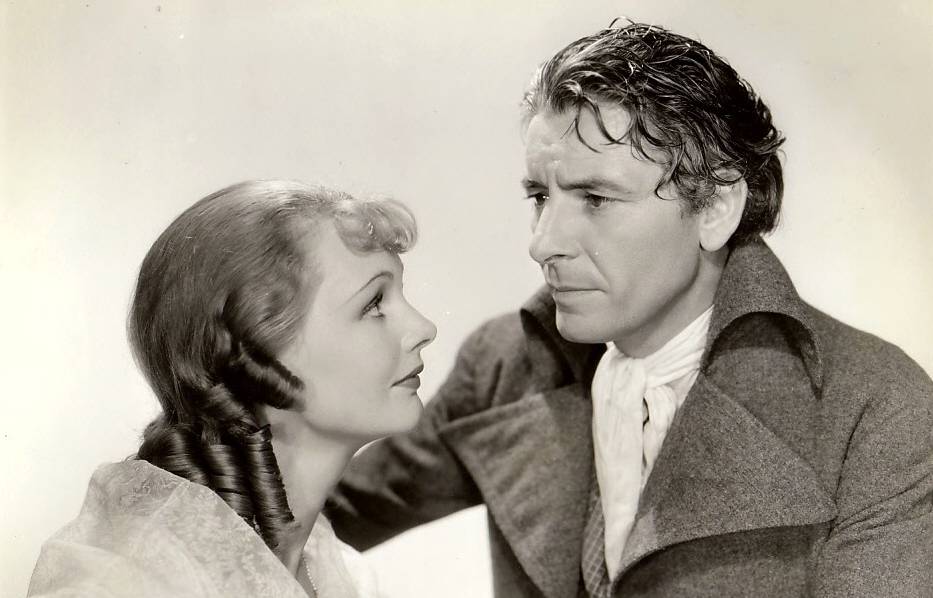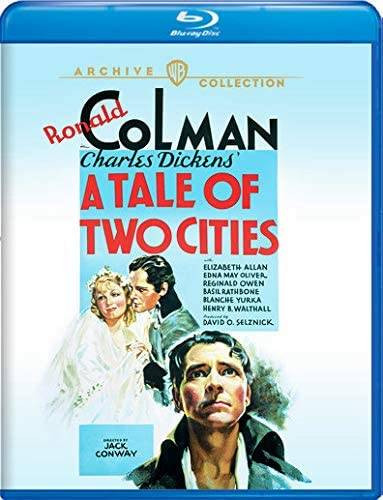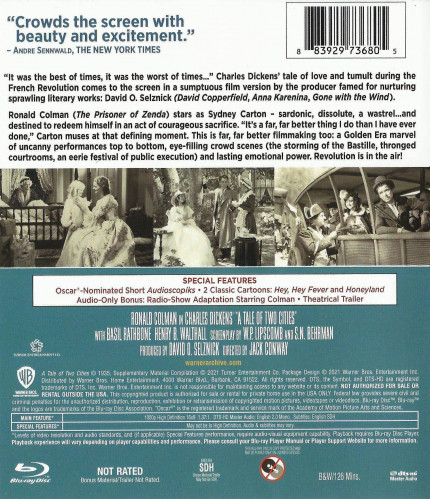A TALE OF TWO CITIES [1935 / 2021] [Warner Archive Collection] [Blu-ray] [USA Release]
Magnificent M-G-M Spectacular of LOVE and HATE!
“It was the best of times, it was the worst of times…” Charles Dickens’ tale of love and tumult during the French Revolution comes to the screen in a sumptuous film version by the producer famed for nurturing sprawling literary works: David O. Selznick [‘David Copperfield,’ ‘Anna Karenina’ and ‘Gone with the Wind’].
Ronald Colman [‘The Prisoner of Zenda’] stars as Sydney Carton – sardonic, dissolute, wastrel . . . and destined to redeem himself in an act of courageous sacrifice. “It's a far, far better thing I do than I have ever done,” Sydney Carton muses at that defining moment. This is far, far better filmmaking too: a Golden Era marvel of uncanny performances from top to bottom, eye-filling crowd scenes with the storming of the Bastille, thronged courtrooms, an eerie festival of public execution, and lasting emotional power. Revolution is in the air!
FILM FACT No.1: Awards and Nominations: 1937 Academy Awards®: Nominated: Best Picture. Nominated: Best Film Editing for Conrad A. Nervig.
FILM FACT No.2: The filming ran from the 4th June, 1935, to the 19th August, 1935. The film premiered in New York City on the 15th December, 1935. The closing credits spell the name De Farge. Charles Dickens spelled it Defarge in the novel. Judith Anderson, May Robson, Emily Fitzroy and Lucille LaVerne all tested for Madame De Farge. Lucille LaVerne's portrayal in another role, as "The Vengeance," inspired the character of the Evil Queen in Disney's Snow White and the Seven Dwarfs: Lucille LaVerne provided the voices for both the Queen and the hag. Blanche Yurka, a noted Broadway actress at the time, made her film debut playing Madame De Farge.
Cast: Ronald Colman, Elizabeth Allan, Edna May Oliver, Reginald Owen, Basil Rathbone, Blanche Yurka, Henry B. Walthall, Donald Woods, Walter Catlett, Fritz Leiber, H.B. Warner, Mitchell Lewis, Claude Gillingwater, Billy Bevan, Isabel Jewell, Lucille La Verne, Tully Marshall, Fay Chaldecott, Eily Malyon, E.E. Clive, Lawrence Grant, Robert Warwick, Ralf Harolde, John Davidson, Tom Ricketts, Donald Haines, Barlowe Borland, Norman Ainsley (uncredited), Richard Alexander (uncredited), Joe Amick (uncredited), Jimmy Aubrey (uncredited), Barbara Barondess (uncredited), May Beatty (uncredited), John Bryan (uncredited), Elsa Buchanan (uncredited), Burr Caruth (uncredited), St. Luke's Episcopal Church Choristers (uncredited), Frank Dawson (uncredited), Nigel De Brulier (uncredited), Chappell Dossett (uncredited), Frank Dunn (uncredited), Harold Entwistle (uncredited), Sam Flint (uncredited), Mary Foy (uncredited), Christian J. Frank (uncredited), Sig Frohlich (uncredited), Dale Fuller (uncredited), Winter Hall (uncredited), Forrester Harvey (uncredited), Edward Hearn (uncredited), Ramsay Hill (uncredited), Billy House (uncredited), Brandon Hurst (uncredited), Boyd Irwin (uncredited), Walter Kingsford (uncredited), Marion Lessing (uncredited), Clinton Lurie (uncredited), James T. Mack (uncredited), James A. Marcus (uncredited), Frank Mayo (uncredited), Shirley McDonald (uncredited), Cyril McLaglen (uncredited), Torben Meyer (uncredited), John Miltern (uncredited), Edward Peil Sr. (uncredited), Tempe Pigott (uncredited), Charles Requa (uncredited), Rolfe Sedan (uncredited), C. Montague Shaw (uncredited), Yorke Sherwood (uncredited), Jay Taylor (uncredited), Joseph R. Tozer (uncredited), Laura Treadwell (uncredited), Judith Vosselli (uncredited), Harry Wilson (uncredited) and Chester Withey (uncredited)
Directors: Jack Conway and Robert Z. Leonard (fill-in director) (uncredited)
Producer: David O. Selznick
Screenplay: Charles Dickens (novel), S.N. Behrman (screenplay), W.P. Lipscomb (screenplay), M. Cléry (bibliography "Journal of the Temple"), M. Nicholas (bibliography "The Memoirs"), Mademoiselle des Écherolles (bibliography "The Memoirs") and Thomas Carlyle (bibliography "The French Revolution")
Composer: Herbert Stothart (musical score)
Costumes: Dolly Tree (wardrobe) and Eugene Joseff (costume jewellery) (uncredited)
Cinematography: Oliver T. Marsh, A.S.C. (Director of Photography)
Image Resolution: 1080p (Black-and-White)
Aspect Ratio: 1.37:1
Audio: English: 2.0 DTS-HD Master Audio
Subtitles: English
Running Time: 126 minutes
Region: All Regions
Number of discs: 1
Studio: Metro-Goldwyn-Mayer / Warner Archive Collection
Andrew’s Blu-ray Review: ‘A TALE OF TWO CITIES’ [1935] is an adaptation of the classic novel by Charles Dickens. It’s no surprise that this adaptation begins with that oft-repeated bit of poetic parallelism. The causes and effects of the French Revolution come alive through this cinematic rendering of the Charles Dickens’ classic novel, “A Tale of Two Cities,” published in 1859. As we will see, there is more to the film ‘A TALE OF TWO CITIES’ than the bloodstained blade of the guillotine.
It is a tale known well, filmed many times over the years, but never better than this early black and white version from the M-G-M Studios, David O. Selznick producing. It was the best of times, it was the worst of times and Charles Dickens juxtaposes England and France, George and Louis, tradition and revolution. One of the most beloved of Dickens' stories, finding not only countries and conditions compared, but also two individuals thrown up in stark contrast to one another: -- the dissolute barrister Sydney Carton [Ronald Colman] and the young, somewhat callow aristocrat Charles Darnay [Donald Woods], both in love with Lucie [Elizabeth Allan], daughter of a victim of the French Regime. Their lives intertwine until the violent revolution that overtook an entire nation engulfs them all as well. Charles Dickens' story has stood the test of time; remade frequently since the release of this 1935 version.
It is this version by director Jack Conway's that is best remembered and to which all others are compared. The settings, cinematography, and direction are all right on the mark, recreating the streets of London and of Paris with great skill and realism. The supporting cast, filled with faces we have grown to cherish like Reginald Owen, Edna May Oliver, Claude Gillingwater, Walter Catlett, H. B. Warner, Basil Rathbone, and E. E. Clive-comes through with crystalline performances which add substance to the inexorable stream of events. Blanche Yurka's bravura turn as Therese de Farge delights us even as we shudder at her intensity. Second unit directors Jacques Tourneur and Val Lewton, who would both go on to memorable careers as leading directors in their own right, staged the storming of the Bastille and other revolutionary scenes brilliantly, managing to combine fervour with panache.
It is, however, Colman's portrayal of the lonely man redeemed by love and sacrifice which stands at the centre of the story. Sydney Carton first saves Charles Darnay from a charge of treason, thereby meeting those who care for him: the beautiful Lucie Manette, her father, Doctor Manette [Henry B. Walthall], released from the Bastille after many years of unjust incarceration; Lucie's servant Miss Pross, [Edna May Oliver] and Mister Lorry [Claude Gillingwater], an functionary of Tellson's Bank. His relationship with this circle of kind friends grows rocky when Charles Darnay marries Lucie, whom Sydney Carton has loved from afar, but even this turn of events cannot change his feelings for them all and he grows to love them even more when daughter Lucie comes along. Charles Darnay reforms, leaving old ways behind and enjoying familial warmth he has never known.
This happy life is shattered when Charles Darnay returns to France during the first revolutionary struggles, intent on saving his old tutor from the guillotine. He soon finds himself behind bars and facing the blade instead. The Revolution does not forget an aristocrat, even one who has recanted and lived life abroad as a commoner. The whole family makes the channel crossing to come to the young man's aid and Sydney Carton seeks a way to save him, discovering only one path to free Charles Darnay and return everyone to safety. It is a sacrifice easily promised and quickly made. Ronald Colman had long wanted to make a film of this story and, when he finally got his chance, he happily shaved off his signature moustache in an appropriate gesture to historical realism.
Reviews of his work indicate his portrayal of Sydney Carton surpassed all his previous endeavours; he had been accused of walking through light parts, once he started making talkies, and not putting his many talents to good use. ‘A TALE OF TWO CITIES’ puts to rest those complaints. Sydney Carton dominates completely the scenes which he does appear, and his skill gives substance to a literary achievement, a melancholy man of intelligence and wit, given to drink and despair, whose life seems to attain meaning only when it is given up for someone else. It is one of the portrayals for which Ronald Colman has come to be remembered. There have been various remake versions of ‘A TALE OF TWO CITIES.’ The not so good weak remake starred Dirk Bogarde who played Sydney Carton in 1958 version. While these and other versions have all been good films, none has achieved the stature of the 1935 version and its excellent combination of star power, technical brilliance and great storytelling.
The scene is set. What follows are images that prove to be deliciously atmospheric with a loving mixture of British colloquialism and Hollywood storytelling all stirred together in an agreeable period drama. Perhaps the highest compliment I can pay this film, directed by Jack Conway, is that it manages to capture some of the essence of Charles Dickens’ novel even if it does not wholly enrapture me as the source material did those many years ago in my freshman honours English class.
1935 was quite the year for big-budget literary adaptations and this is a fine one. It is rescued from an excess of sentiment that was also present in the novel by the fantastic performance of Ronald Colman as Sidney Carton. His eyes are wonderfully expressive and he delivers his dialogue with just the right touch of irony. Among the supporting players, I particularly like Basil Rathbone as the supercilious Marquis and Edna May Oliver as Lucie’s maid, Miss Pross. Edna May Oliver has a really touching and funny scene near the end in which she defends the interests of her mistress. M-G-M spared no expense on the settings or costumes.
This classic story by Charles Dickens which takes place during the French Revolution is, by far, the best adaptation of his novel. It stars Ronald Colman in his best performance in my opinion, which is the very essence of Sydney Carton and includes great character actors like Edna May Oliver and Basil Rathbone. Being done at early sound M-G-M, its sets are very colourful and the characters are full of life. The film ‘A TALE OF TWO CITIES’ captures the essence of Charles Dicken’s novel superbly and it’s the kind of film I love to watch when it’s snowing outside.
A TALE OF TWO CITIES MUSIC TRACK LIST
La Marseillaise (1792) (uncredited) (Written by Claude Joseph Rouget de Lisle) [Played during the opening credits and often in the score]
Romance No.6, Op.6 (None But the Lonely Heart) (1869) (uncredited) (Music by Pyotr Ilyich Tchaikovsky) Played as background music]
Egmont Overture, Op. 84 (1809 – 1810) (uncredited) (Written by Ludwig van Beethoven) (Freely arranged by Herbert Stothart) [Played as background music]
Prelude Opus 28 No. 7 (1834) (uncredited) (Written by Frédéric Chopin) (Arranged by Herbert Stothart) [Played in several scenes]
God Rest Ye Merry, Gentlemen (uncredited) (Traditional) [Sung by carolers on Christmas Eve]
Hark! The Herald Angels Sing (uncredited) (Music by Felix Mendelssohn Bartholdy) (1840) (Lyrics by Charles Wesley) (1730) [Sung by a choir in church]
Adeste Fideles (1782) (uncredited) (Music by John Francis Wade) (1782) (Arranged by David Snell) [Latin lyrics traditional sung in church by an unseen female] [English lyrics "Come, All Ye Faithful" by Frederick Oakeley (1852) sung by a group passing by]
* * * * *
Blu-ray Image Quality – Warner Archive Collection presents the film ‘A TALE OF TWO CITIES’ with a 1.37:1 theatrical aspect ratio is faithfully reproduced in this superb 1080p image transfer and arrives on this Blu-ray disc for the first time with a brand new master. I’m guessing that’s a 2K scan at best. And it looks pretty great. I wouldn’t say it’s got that fresh, new look to it, but it does make it feel surprising to be a film made in 1935 with how good the restoration work is. Details are solid with a nice, crisp image that keeps its grain structure intact. All in all, this is a very good look that those interested will appreciate. Actors and backgrounds have good distancing and special separation. Movements are filmic, smooth and have no issues with distortions. Blacks are deep, heavier grained in darker areas. It provides a nice shadow and shading on the image. Not a lot of information is swallowed by it, still revealing textures and patterns. Flesh tones are a white and grey mixture consistent from start to finish. Close ups typically provide the best and most detailed information of facial textures and features.
Blu-ray Audio Quality – Warner Archive Collection brings us the film ‘A TALE OF TWO CITIES’ with a standard 2.0 DTS-HD Master Audio experience, which is a sound mix that is solid if not quite perfection. There is some attenuated hiss that can be heard in the quieter scenes, but it’s never too distracting, and there are no problems with flutter, pops, or crackle. The dialogue is easily discernible and has been mixed with Herbert Stothart’s background music, much of it carols and other familiar tunes, and the sound effects with great clarity.
* * * * *
Blu-ray Special Features and Extras:
Special Feature: ‘A TALE OF TWO CITIES’ LUX Radio Theatre Broadcast [Audio only] [1942] [1080p] [1.78:1] [58:30] ‘A TALE OF TWO CITIES’ was broadcast on the 12th January, 1942 and was sponsored by: LUX Soap. This is the classic narrative of the French Revolution that occurred in France known as the Reign of Terror. The story was produced on The Lux Radio Theatre. Voice Cast: Julie Bannon (commercial spokesman), Griff Barnett, Edna Best, Arthur Q Bryan, Torey Carleton, Ronald Colman, Jeff Corey, Boyd Davis, Verna Felton, Kathleen Fitz, Denis Green, Alec Harford, Halliwell Hobbes, Edwin Max, Thomas Mills, Ferdinand Munier, Charles Seel, Eric Snowden, Don Thompson (commercial spokesman) and George Wells (adaptor).
Special Feature: M-G-M Vintage Cartoon: Hey-Hey Fever [1935] [1080i] [1.37:1] [8:24] This M-G-M "Happy Harmonies" cartoon stars Bosko and Bruno are sadly walking at the park. Bosko packed sandwiches but he lets Bruno eat it all so Bosko only ate the crumb pieces. Bosko then falls asleep dreaming he is at Mother Goose's house in the country. Then Bosko follows her by another house. Then Bosko goes off on his own to a Shoe-footed house. Bosko then sees a mother with a lot of babies and he then sees young children wanting candy. Bosko then goes on the dirt road with Mother Goose and the mom and her babies. They then approach a guy looking similar to Pinocchio. Bosko goes inside a knight like house and then meets up with a king. Bosko later then leads a parade to a farmer's house and leads the parade again all the way to another house to have dinner with everyone. Everyone is happy as the cartoon ends. Voice Cast: Billy Bletcher [Old King Cole] (uncredited), Rochelle Hudson [Honey] (uncredited) and Carman Maxwell [Bosko] (uncredited) (unconfirmed). Directors: Hugh Harman (uncredited) and Rudolf Ising (uncredited). Producers: Hugh Harman and Rudolf Ising. Composer: Scott Bradley.
Special Feature: M-G-M Vintage Cartoon: Honeyland [1935] [1080p] [1.37:1] [10:07] This M-G-M "Happy Harmonies" cartoon cartoon in which a group of industrious bees, are harvesting nectar from flowers to make honey, as the camera turns to a trio of singing bees. They perform the song as bees are shown making honey, using ways like human techniques of farming, a stereotypical “French chef” tasting it, and melting candle wax to preserve, a reference to beeswax. Two bees are shown chasing each other, outside the safety of the hive. Then, the antagonist (a spider) comes in and chases and captures the female bee. The male bee tries to fight the spider, and the female escapes. Using a flower as a rotary telephone, she contacts the operator, telling him to call for all bees. They come into formation, as the spider tries to escape. To a part of Rimsky-Korsakov's Flight of the Bumblebee, the group continually stung the spider's abdomen, and the spider runs off. The female bee goes to aid the male bee, and with a kiss, he is happy, and all the bees cheer. Voice Cast: Brox Sisters [Bee's] (uncredited). Director: Rudolf Ising (uncredited). Producers: Hugh Harman and Rudolf Ising. Composer: Scott Bradley.
Special Feature: Audioscopiks [1935] [480i] [1.37:1] [8:14] This forerunner to the long-running “Pete Smith Specialty” series received an Oscar nomination for Best Short Subject, Novelty. Commentator Pete Smith gives us this very informative and entertaining short giving a lesson on how 3-Dimensional movies are made. After being taught about 3-D, patrons are then instructed to put on their 3-D glasses. They are then given a demonstration of 3-D with various objects moving towards the camera, including a ladder, a baseball being thrown and a woman on a swing. Smith narrates each short clip, most being 20 seconds or less. It's just too bad the short couldn't have been presented in actual 3D on this Blu-ray disc, but despite this, the short remains a great deal of fun even if it is only viewed with a 2D image.
Re-issue Trailer [1935] [1080p] [1.37:1] [1:17] This is the Re-issue Theatrical Trailer for the film ‘A TALE OF TWO CITIES.’
Finally, there have been many fine adaptations of Charles Dickens' novels, but the 1935 version of ‘A TALE OF TWO CITIES’ stands out as one of the best. M-G-M's stirring, and impressive production brings the turbulence of the French Revolution and all of Charles Dickens' colourful characters to brilliant life as it chronicles the impact of the peasant rebellion on a humble family. This new HD master and excellent audio revitalize this classic Hollywood film, which still dazzles the senses and tugs at the heartstrings 85 years after its initial release. ‘A TALE OF TWO CITIES’ is a very classic and nice adaptation that feels quite grand and epic for the 1930’s prior to the end of the decade when stuff really starts taking off. Warner Archive Collection has put together a wonderful Blu-ray here that has them showing some effort in doing what they can with such an old film of the 1930’s and quite nice bonus material. The image transfer is pretty nice as well. The film is definitely for any classic film fan and especially for collectors who may want to consider grabbing to have in their Blu-ray collection. Highly Recommended!
Andrew C. Miller – Your Ultimate No.1 Film Aficionado
Le Cinema Paradiso
United Kingdom



